Abstract
Forty sets of parents and 24 sibs of patients with tuberous sclerosis were investigated by an extensive protocol, including clinical examination of skin, hair, and oral cavity, direct and indirect ophthalmoscopy, cranial CT scan, renal ultrasound, and a radiological skeletal survey. None of the clinical examinations provided evidence that any of the subjects was affected. Similarly, the cranial CT scan, renal ultrasound, and skeletal survey failed to identify any occult gene carriers. All of these investigations showed abnormalities in some parents but none was diagnostic. This study shows the difficulties in interpretation that these investigations may produce with consequent problems for genetic counselling. The study does not support the routine use of these tests. There are published reports where the diagnosis of tuberous sclerosis has been made in adults exclusively on a CT scan and an argument can be made for including this investigation. There is no indication for performing renal ultrasound nor skeletal x rays in parents who have normal clinical examinations.
Full text
PDF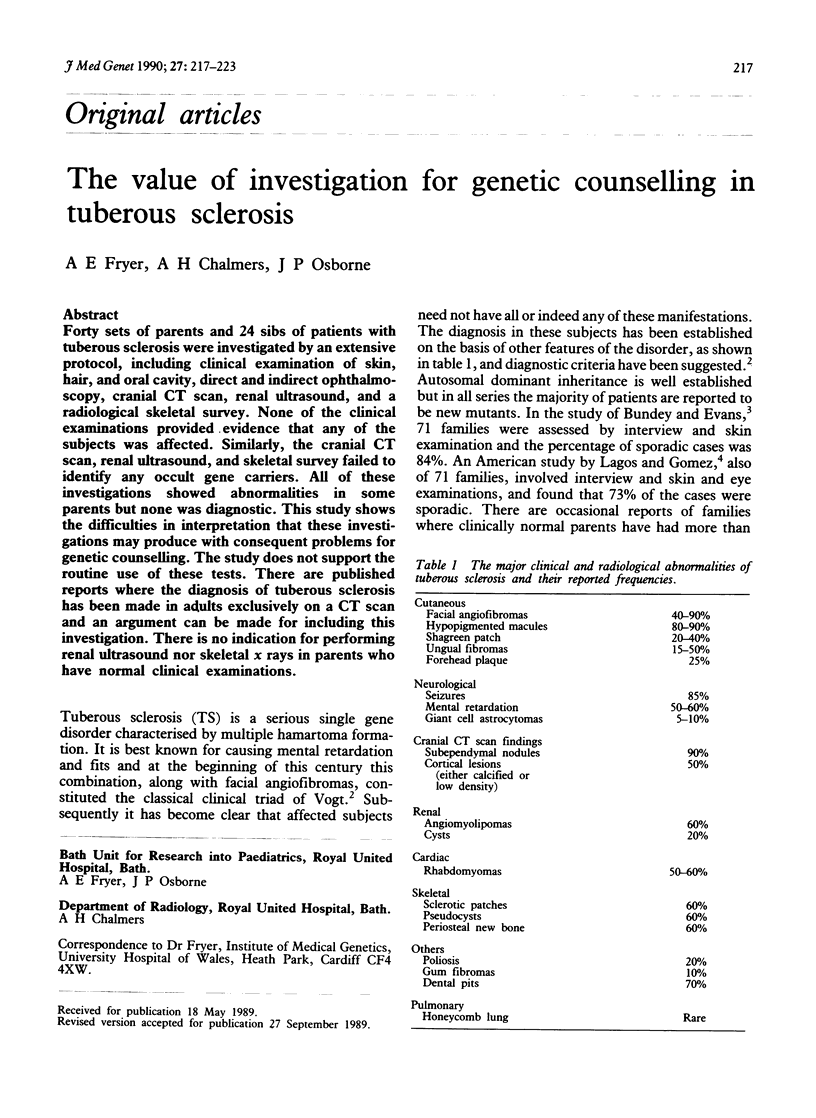

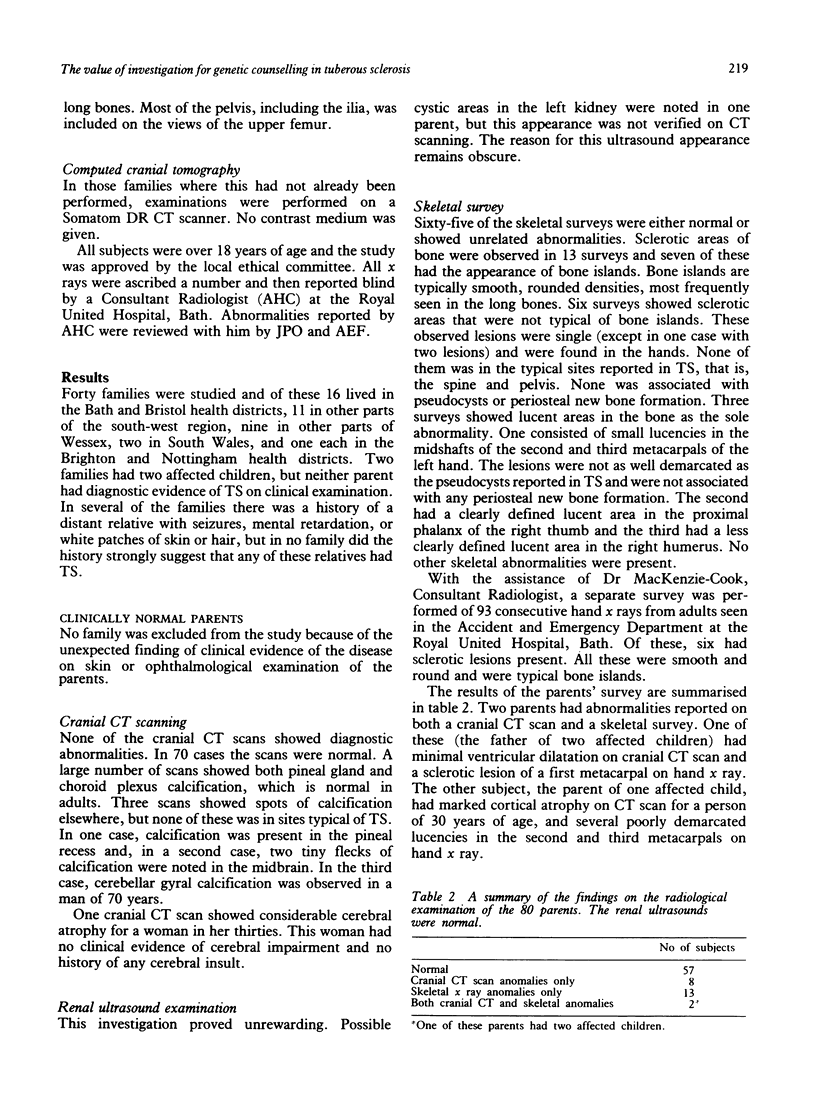
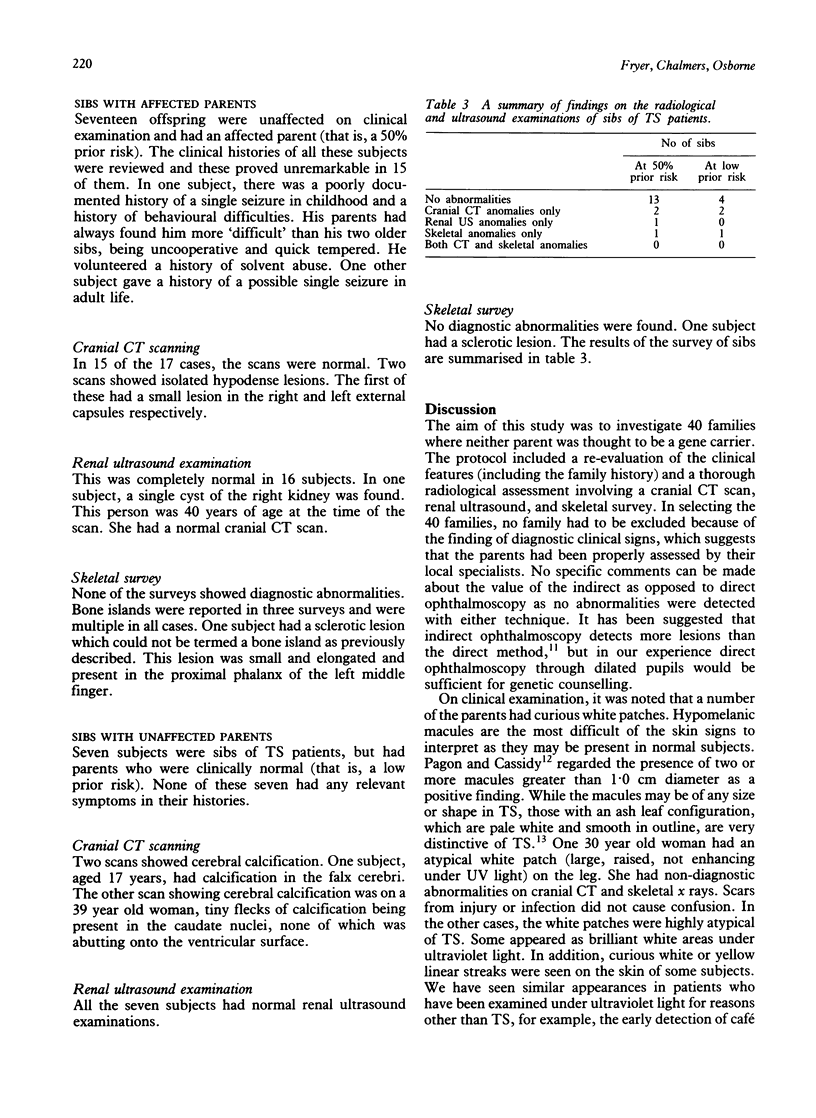
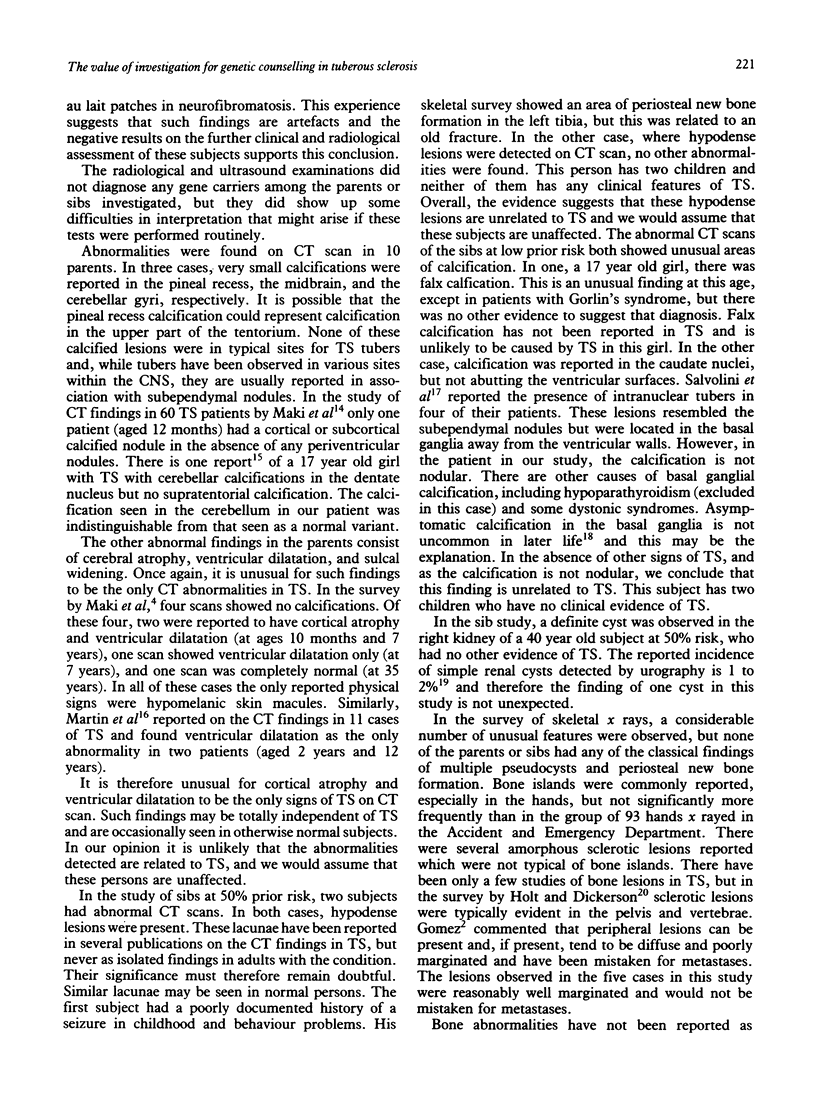
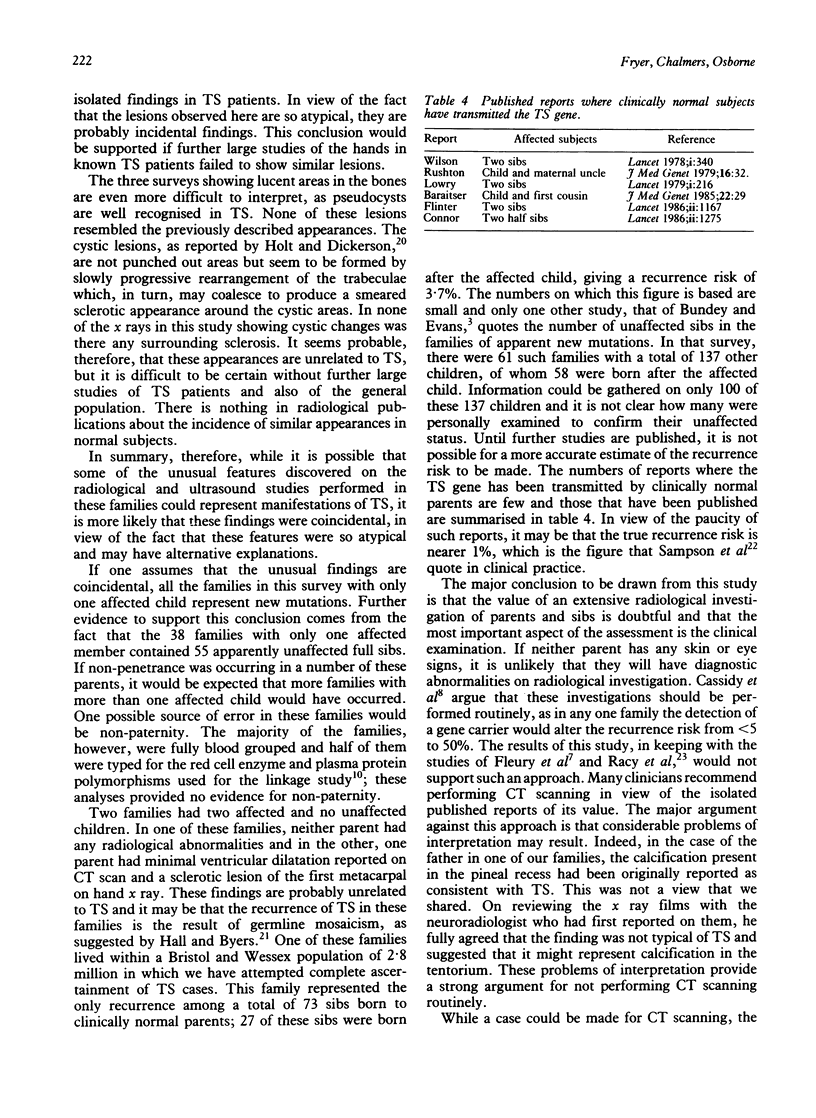
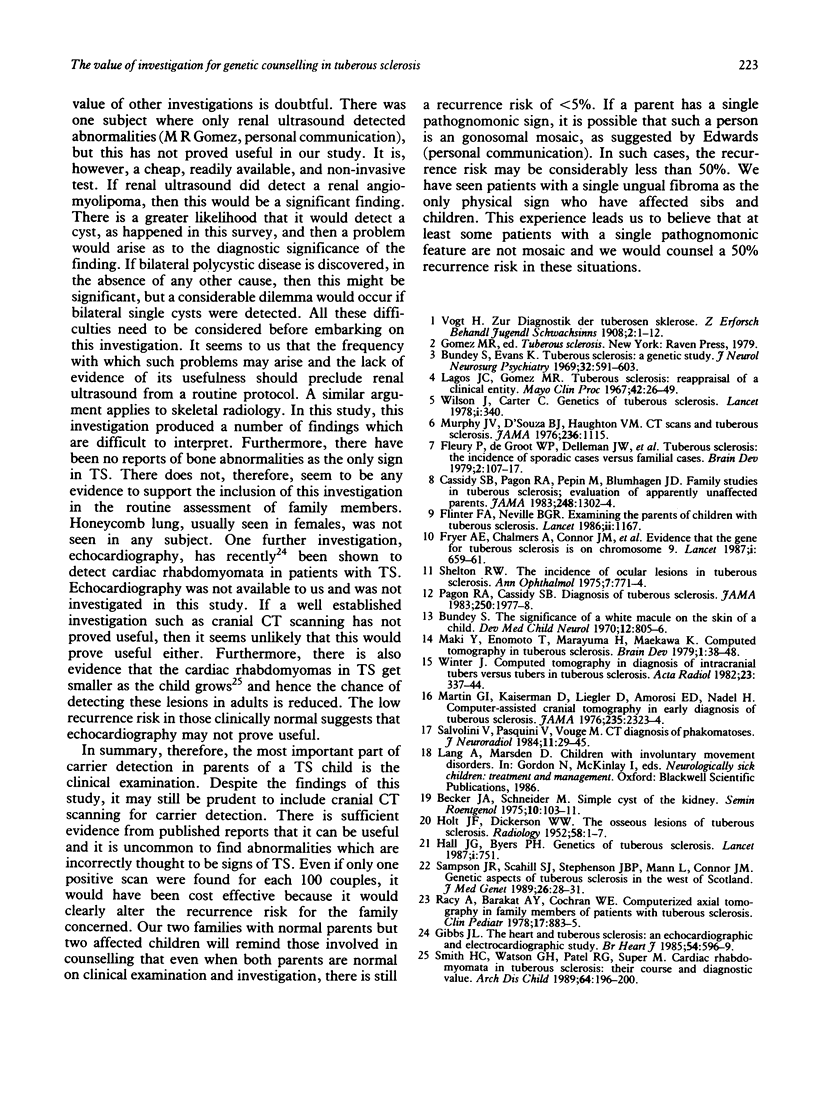
Selected References
These references are in PubMed. This may not be the complete list of references from this article.
- Becker J. A., Schneider M. Simple cyst of the kidney. Semin Roentgenol. 1975 Apr;10(2):103–111. doi: 10.1016/0037-198x(75)90034-6. [DOI] [PubMed] [Google Scholar]
- Bundey S., Evans K. Tuberous sclerosis: a genetic study. J Neurol Neurosurg Psychiatry. 1969 Dec;32(6):591–603. doi: 10.1136/jnnp.32.6.591. [DOI] [PMC free article] [PubMed] [Google Scholar]
- Bundey S. The significance of a white macule on the skin of a child. Dev Med Child Neurol. 1970 Dec;12(6):805–806. doi: 10.1111/j.1469-8749.1970.tb07876.x. [DOI] [PubMed] [Google Scholar]
- Cassidy S. B., Pagon R. A., Pepin M., Blumhagen J. D. Family studies in tuberous sclerosis. evaluation of apparently unaffected parents. JAMA. 1983 Mar 11;249(10):1302–1304. [PubMed] [Google Scholar]
- Fleury P., de Groot W. P., Delleman J. W., Verbeeten B., Jr, Frankenmolen-Witkiezwicz I. M. Tuberous sclerosis: the incidence of sporadic cases versus familial cases. Brain Dev. 1980;2(2):107–117. doi: 10.1016/s0387-7604(80)80031-3. [DOI] [PubMed] [Google Scholar]
- Flinter F. A., Neville B. G. Examining the parents of children with tuberous sclerosis. Lancet. 1986 Nov 15;2(8516):1167–1167. doi: 10.1016/s0140-6736(86)90581-7. [DOI] [PubMed] [Google Scholar]
- Fryer A. E., Chalmers A., Connor J. M., Fraser I., Povey S., Yates A. D., Yates J. R., Osborne J. P. Evidence that the gene for tuberous sclerosis is on chromosome 9. Lancet. 1987 Mar 21;1(8534):659–661. doi: 10.1016/s0140-6736(87)90416-8. [DOI] [PubMed] [Google Scholar]
- Gibbs J. L. The heart and tuberous sclerosis. An echocardiographic and electrocardiographic study. Br Heart J. 1985 Dec;54(6):596–599. doi: 10.1136/hrt.54.6.596. [DOI] [PMC free article] [PubMed] [Google Scholar]
- HOLT J. F., DICKERSON W. W. The osseous lesions of tuberous sclerosis. Radiology. 1952 Jan;58(1):1–8. doi: 10.1148/58.1.1. [DOI] [PubMed] [Google Scholar]
- Maki Y., Enomoto T., Maruyama H., Maekawa K. Computed tomography in tuberous sclerosis--with special reference to relation between clinical manifestations and CT findings. Brain Dev. 1979;1(1):38–48. [PubMed] [Google Scholar]
- Martin G. I., Kaiserman D., Liegler D., Amorosi E. D., Nadel H. Computer-assisted cranial tomography in early diagnosis of tuberous sclerosis. JAMA. 1976 May 24;235(21):2323–2324. [PubMed] [Google Scholar]
- Murphy J. V., D'Souza B. J., Haughton V. M. Letter: CT scans and tuberous sclerosis. JAMA. 1976 Sep 6;236(10):1115–1115. [PubMed] [Google Scholar]
- Racy A., Barakat A. Y., Cochran W. E. Computerized axial tomography in family members of patients with tuberous sclerosis. Clin Pediatr (Phila) 1978 Dec;17(12):883–885. doi: 10.1177/000992287801701202. [DOI] [PubMed] [Google Scholar]
- Salvolini U., Pasquini U., Vouge M. CT diagnosis of phakomatosis. J Neuroradiol. 1984;11(1):29–45. [PubMed] [Google Scholar]
- Sampson J. R., Scahill S. J., Stephenson J. B., Mann L., Connor J. M. Genetic aspects of tuberous sclerosis in the west of Scotland. J Med Genet. 1989 Jan;26(1):28–31. doi: 10.1136/jmg.26.1.28. [DOI] [PMC free article] [PubMed] [Google Scholar]
- Shelton R. W. The incidence of ocular lesions in tuberous sclerosis. Ann Ophthalmol. 1975 Jun;7(6):771–774. [PubMed] [Google Scholar]
- Smith H. C., Watson G. H., Patel R. G., Super M. Cardiac rhabdomyomata in tuberous sclerosis: their course and diagnostic value. Arch Dis Child. 1989 Feb;64(2):196–200. doi: 10.1136/adc.64.2.196. [DOI] [PMC free article] [PubMed] [Google Scholar]
- Steffen C. Diagnosis of tuberous sclerosis. JAMA. 1983 Oct 21;250(15):1977–1978. [PubMed] [Google Scholar]
- Winter J. Computed tomography in diagnosis of intracranial tumors versus tubers in tuberous sclerosis. Acta Radiol Diagn (Stockh) 1982;23(4):337–344. doi: 10.1177/028418518202300401. [DOI] [PubMed] [Google Scholar]


